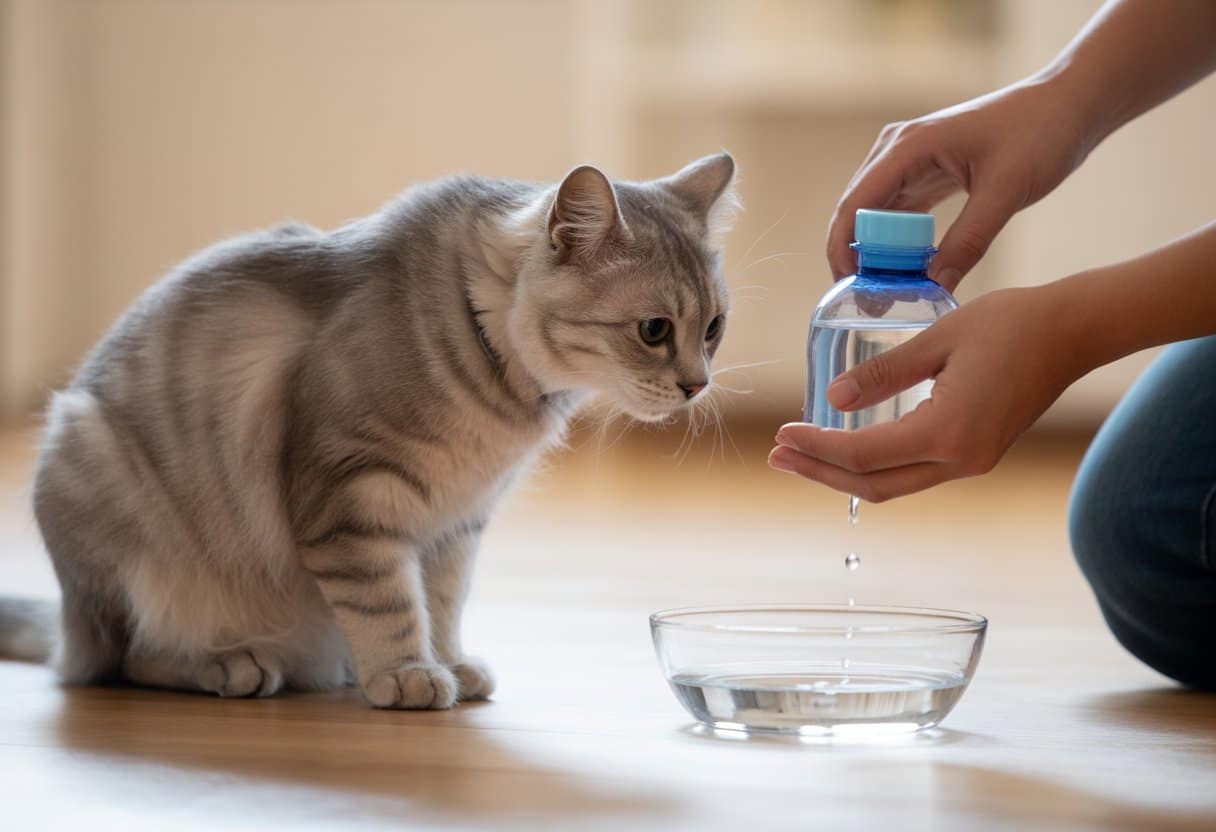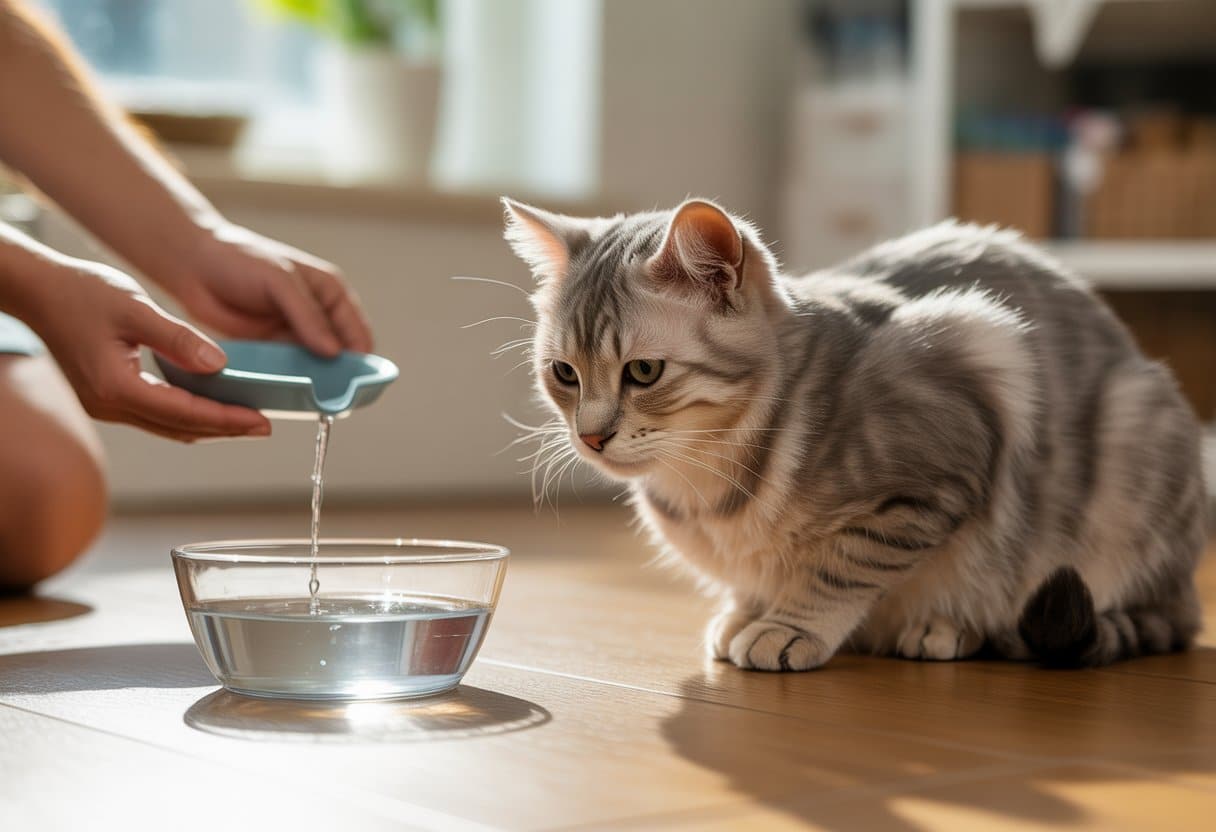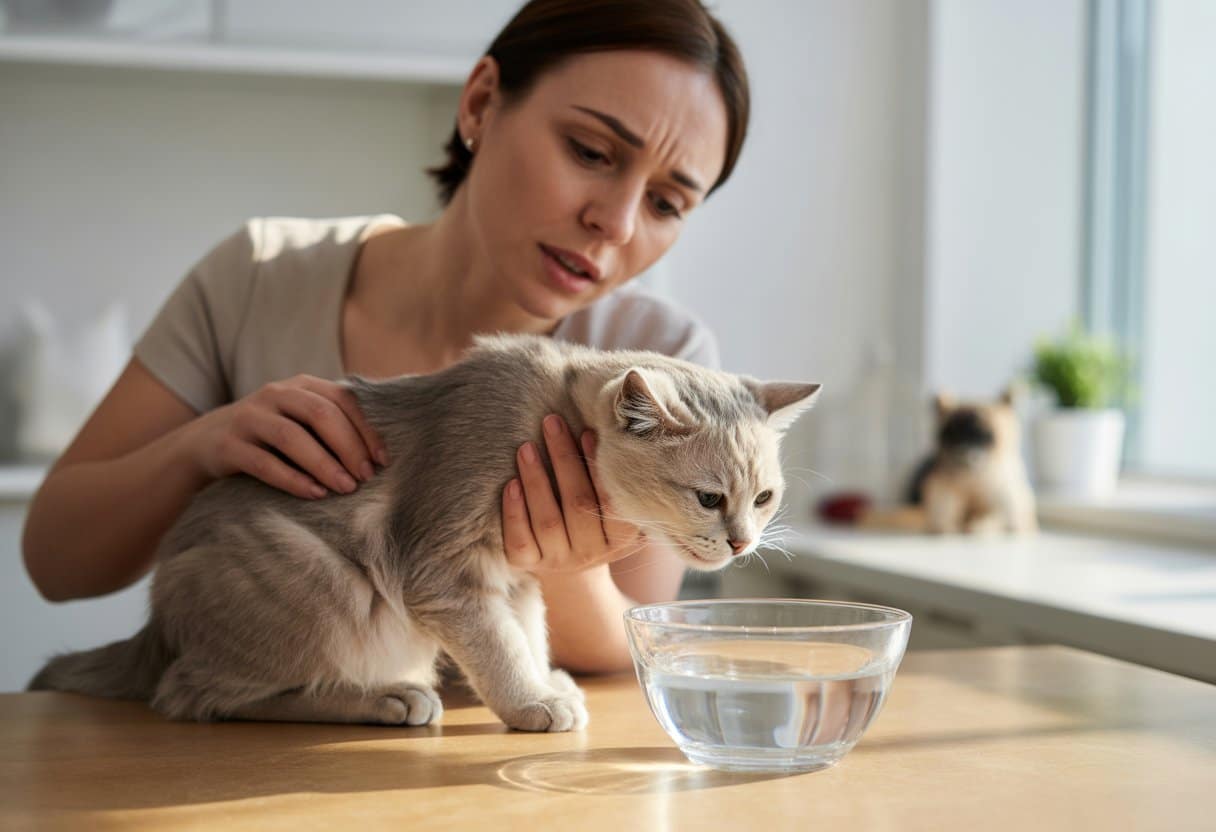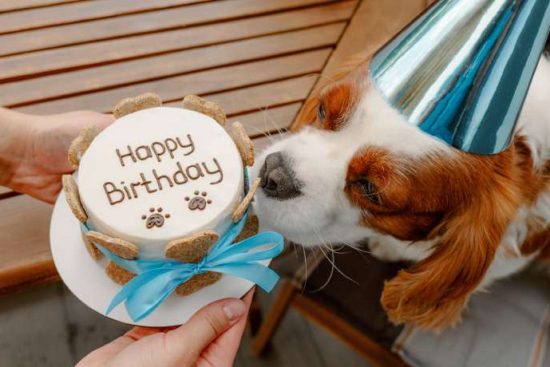
Cats are pretty skilled at masking illness, which makes dehydration a sneaky health threat that a lot of pet owners miss until things get dicey. Unlike dogs, cats evolved from desert creatures and just aren’t naturally big drinkers, so they often don’t get enough water without some help.
The key warning signs of dehydration in cats include lethargy, dry gums, sunken eyes, and skin that doesn’t snap back quickly when pinched.
Dehydration develops quickly in cats and can lead to kidney problems, organ damage, and other serious health issues if left untreated. Hot weather, illness, stress, and even the kind of food your cat eats can mess with hydration levels.
Just knowing these warning signs—and how to get your cat to drink more—can honestly make the difference between a healthy pet and an emergency vet bill.
Key Takeaways
- Watch for lethargy, dry gums, sunken eyes, and slow skin recoil as early warning signs of dehydration in cats
- Use fresh water bowls, fountains, wet food, and multiple water stations to encourage regular drinking
- Seek immediate veterinary care for severe symptoms like extreme weakness, rapid breathing, or collapse
Recognizing Symptoms of Dehydration in Cats
Cats show physical signs when they’re dehydrated, and most pet owners can check these at home. The most reliable indicators include reduced energy, gum changes, skin that doesn’t bounce back, and eyes that look sunken.
Lethargy and Weakness
Dehydrated cats become less active and often sleep more than usual. They might move slowly or seem oddly hesitant to jump up on things or play.
A cat experiencing dehydration may show decreased energy and look tired even after a nap. Sometimes, you’ll find your cat just lying in the same spot for hours, not bothering to eat, drink, or visit the litter box.
Weakness can show up fast. Some cats will stumble or struggle to stand up from lying down.
Severe lethargy requires immediate attention. If your cat can’t lift their head or respond to your voice, it’s time to call the vet—no hesitation.
Dry or Sticky Gums
Healthy cat gums feel moist and a little slippery. Dehydrated cats get dry and sticky gums that feel tacky when you press them.
Normal gums should look pink and wet. You can check by gently lifting your cat’s lip and touching the gum above the teeth.
Dehydrated gums tend to feel rough or sticky instead of smooth and moist. The saliva gets thick and stringy, too.
Color changes can happen along with the texture changes. Gums might turn pale pink or even white if things get bad.
This is a quick test—takes seconds, honestly. It’s worth checking especially during hot spells or if your cat’s under the weather.
Loss of Skin Elasticity
The skin tent test reveals dehydration by showing how fast the skin returns after you lift it. Try gently pinching the skin at the back of your cat’s neck.
Healthy, hydrated cats have skin that snaps back right away. It should settle back in a second or so.
Dehydrated cats show slow skin return. Sometimes, the skin just stays tented for a few seconds.
Location matters for this test. The scruff is usually best since the skin’s loose there.
Older cats have less elastic skin by default, so this test’s mostly useful on younger adults. Try it when your cat’s healthy to get a baseline feel.
Sunken Eyes
A cat’s eyes should look bright and full in their sockets. Dehydration causes sunken eyes as fluid drops throughout the body.
Sunken eyes look deeper set and might seem dull or tired. You’ll see shadows around the eyes, and they might look smaller than usual.
This often shows up with other dehydration signs. Sometimes, the eyes just seem less lively.
Third eyelids can become more visible, too. That’s the white or pinkish membrane in the corner of each eye—if it’s creeping over the eye, it’s not a good sign.
Eye changes mean dehydration’s getting serious. If you spot this, a vet visit is probably in order.
Behavioral and Physical Changes to Monitor
Cats show dehydration through odd changes in their daily routines and appearance. These signs of dehydration in cats include eating less, bathroom habit changes, odd breathing, and coat issues.
Decreased Appetite
A dehydrated cat often just isn’t interested in food. Their body shifts energy to the basics and kind of ignores digestion.
You might see your cat sniff food and walk away. Some will nibble a little, then stop. Others just turn their nose up entirely.
Early signs include:
- Food sitting in the bowl longer than usual
- Eating treats but skipping meals
- Taking ages to finish dinner
When cats don’t have enough fluids, their stomach and guts don’t work right. That can make eating feel uncomfortable or even a bit nauseating.
Behavioral changes from dehydration often start with mild food avoidance. If dehydration gets worse, appetite loss gets more obvious.
Cats who usually beg for food might suddenly not care. It’s especially noticeable in cats that are normally food-obsessed.
Changes in Urination
Dehydrated cats pee less than normal. You’ll see changes in their litter box habits.
Most cats urinate a couple of times a day. Dehydrated cats might go a whole day or more without peeing, and the urine that’s there is darker yellow or even orange.
Watch for these changes:
- Fewer wet spots in the litter box
- Stronger urine odor
- Straining to urinate
- Tiny amounts of urine
Sometimes, cats urinate outside the box because they associate it with discomfort.
Kidney function changes when cats are dehydrated. The kidneys try to save water by making less urine.
It helps to clean litter boxes daily—you’ll notice changes faster. Clumping litter is especially handy for spotting differences in urine amount and color.
Panting or Increased Breathing
Cats usually breathe quietly through their nose. If they’re panting or breathing faster, dehydration might be the culprit.
Cats aren’t like dogs—they rarely pant unless something’s up. A dehydrated cat might pant to cool off, or their breathing might just get faster or more shallow.
Breathing changes include:
- Open-mouth breathing
- Quick chest movements
- Visible effort to breathe
- Restlessness while breathing
Environmental factors affecting hydration like hot weather make panting more likely. Some cats also pant after activity if they’re low on fluids.
Normally, you shouldn’t really notice your cat’s breathing. If you can see or hear it clearly, pay attention.
Panting plus other dehydration signs means you should act fast. This pattern shows the cat’s body is struggling.
Dull Coat or Shedding
A cat’s coat is a pretty good hydration indicator. Dehydrated cats develop coat issues that aren’t hard to spot.
Healthy fur feels soft and looks shiny. Physical signs of dehydration include fur that’s dull, dry, or rough to the touch.
The coat might shed more than normal. Dead hair doesn’t fall out right when cats are dehydrated, so when they groom, more comes loose at once.
Coat changes to watch for:
- Loss of shine
- Rough texture
- More hair on furniture or clothes
- Matted areas from less grooming
Dehydration dries out the skin under the fur, making the coat look and feel off.
Cats may also groom less when dehydrated, which just makes the coat situation worse. Brushing helps you catch these changes early, too.
Common Causes of Dehydration in Cats

Dehydration in cats happens when they lose more fluids than they take in, or just plain don’t drink enough. The three big triggers? Poor drinking habits, serious health problems, and digestive issues that cause rapid fluid loss.
Inadequate Water Intake
Most cats just don’t drink enough water on their own. It’s not really their fault—cats are descended from desert-dwelling ancestors, so their thirst drive is pretty minimal compared to, say, dogs.
Location and accessibility matter more than you’d think. If a water bowl sits too close to your cat’s food or litter box, chances are they’ll avoid it.
Dirty or stale water? Forget it. Cats are picky and will skip drinking if the water doesn’t meet their standards.
Some cats are obsessed with moving water. Cat drinking fountains have become increasingly popular because the gentle trickle and bubbling sounds seem to entice even the most stubborn drinkers.
Diet choices are a big deal, too. If your cat only eats dry kibble, they’re getting maybe 10% water from food, while wet food offers 75-80%.
Age can throw a wrench into things. Older cats might drink less, whether due to stiff joints or simply forgetting to visit the water bowl.
Underlying Medical Conditions
Some health issues directly trigger dehydration in cats by messing with how their bodies manage fluids.
Chronic kidney disease is the big one. Damaged kidneys lose the ability to concentrate urine, so cats with this problem end up peeing out much more water than normal.
Diabetes is another culprit. Diabetic cats urinate frequently and in large amounts as their bodies try to flush out excess sugar.
With hyperthyroidism, everything speeds up—including water loss. Even though these cats drink a lot, they can’t keep up with the extra fluid demands.
Urinary tract infections or blockages make urination painful or impossible, so cats might avoid drinking or become dangerously dehydrated if urine flow stops altogether.
Some medications, especially diuretics, can also increase fluid loss and make it tough to keep a cat hydrated.
Vomiting and Diarrhea
Digestive troubles can cause a cat to lose fluids at an alarming rate.
Vomiting strips away not just water, but also electrolytes like sodium and potassium. If a cat keeps throwing up, they can’t hold down any fluids they try to drink.
Diarrhea is just as bad, maybe worse. Loose stools are packed with water, and vomiting and diarrhea can lead to dehydration incredibly fast.
Causes range from food poisoning to parasites or inflammatory bowel disease. Even stress or a sudden diet change can upset a sensitive stomach.
Kittens and elderly cats are especially at risk. Their bodies just can’t bounce back from fluid loss the way a healthy adult cat’s can.
How to Diagnose Dehydration in Your Cat
There are a couple of quick tests you can try at home: the skin tent test and checking your cat’s gums. Still, nothing beats a vet’s exam for accuracy and peace of mind.
Skin Tent Test
The skin pinch test works best on young, healthy cats with nice, elastic skin. It’s not as reliable for older cats or those with chronic health problems.
To try it, gently lift the skin over your cat’s shoulder blades with your thumb and forefinger. Let go and watch how quickly the skin returns to normal.
Normal Response: The skin snaps right back into place.
Dehydration Signs: The skin slowly settles back or forms a little “tent” that hangs around for a few seconds.
If the skin stays tented for more than two seconds, that’s a red flag. The slower the return, the more dehydrated the cat.
This test isn’t perfect for seniors, overweight cats, or those with skin issues. Their skin just doesn’t bounce back the same way.
Gum Test
Checking the cat’s gums provides a reliable way to assess hydration status at any age. This one works for pretty much every cat, regardless of age or health.
Lift your cat’s lip and look at the gums. Press your finger against the gum and pay attention to how it feels and what color it is.
Normal Gums:
- Wet and slippery, not sticky
- Healthy pink color
- Turns pale briefly when pressed, then returns to pink right away
Dehydrated Cat Gums:
- Dry or tacky to the touch
- Pale or even white
- Slow to return to pink after pressing (think more than 2 seconds)
The capillary refill test is basically timing how long it takes for color to return after pressing. One to two seconds is normal—anything longer, and you should be concerned.
Veterinary Assessment
When in doubt, the vet’s office is the place to go. Veterinarians use multiple methods to figure out how severe dehydration is and what’s causing it.
Physical Examination:
- Heart rate and blood pressure checks
- Body temperature
- Energy and alertness
- Look for sunken eyes
Laboratory Tests:
- Blood work to check electrolytes
- Kidney function
- Urine analysis for concentration
- Complete blood count
Vets usually classify dehydration as mild (5%), moderate (6-9%), or severe (10-12%). Each level calls for a different approach.
They’ll also look for the root cause—maybe kidney disease, diabetes, or gut issues. Catching dehydration early makes treatment so much easier.
Immediate Steps if Your Cat Shows Dehydration Symptoms

If your cat’s showing signs of dehydration, don’t wait around. Give them access to fresh water right away and decide if a vet visit is needed based on how bad things look.
Providing Fresh Water
Get clean, fresh water in front of your cat ASAP. Scrub the bowl and fill it with water that’s not too cold or hot—room temperature works best.
Scatter a few water bowls around the house, especially in quiet spots away from food and litter. Sometimes cats just want privacy when they drink.
For cats who turn up their nose at bowls, try a water fountain or even a dripping faucet. The sound and movement can be surprisingly irresistible.
Wet food can supplement fluid intake—mix it with a splash of water or low-sodium broth to make a soupy meal. It’s a sneaky way to get more fluids in.
Some cats like ice cubes in their water, especially on hot days. The floating cubes and chill might tempt them to take a sip.
When to Contact the Veterinarian
If you see serious symptoms, don’t hesitate—get to the vet. Signs that require urgent care are things like sunken eyes, weakness, collapse, or panting.
Call your vet within hours if your cat:
- Won’t drink, no matter what you try
- Has sticky, dry gums
- Shows skin that stays tented for more than two seconds after pinching
- Seems lethargic or just “not there”
Kittens and seniors? They need professional evaluation even sooner. These groups can go downhill fast.
If your cat already has health issues like diabetes or kidney disease, don’t risk it—get them checked out right away. Dehydration hits them harder and is tougher to manage at home.
Administering Fluids at Home
Don’t force water into your cat’s mouth with a dropper or syringe. It’s risky and could send water into their lungs, which is way worse than dehydration.
Instead, offer small sips often. A teaspoon every few minutes is easier for them to handle and less likely to upset their stomach.
You can try unflavored electrolyte solutions (like Pedialyte) in tiny amounts, but avoid anything with sweeteners or artificial flavors—those can be harmful.
Safe fluid options:
- Plain water
- Low-sodium chicken broth (cooled)
- Tuna juice from canned tuna in water
- Diluted, unseasoned bone broth
Keep a close eye on your cat while you’re trying home remedies. Professional veterinary care becomes essential if things don’t improve or get worse within a few hours.
Tips to Encourage Your Cat to Drink More Water
Water fountains are a game changer for many cats, and wet food adds much-needed moisture. Sometimes, just tweaking where you put the bowls or adding a little flavor can make all the difference.
Using Cat Water Fountains
Cats tend to prefer moving water. Water fountains can help encourage drinking because the sound and movement tap into their natural instincts.
It’s almost funny—some cats will ignore a bowl but drink happily from a fountain. The constant motion catches their eye and keeps them interested.
Plus, fountains keep water fresher by circulating it, which cuts down on bacteria growth and keeps things tasting better.
Key fountain benefits:
- Fresh, filtered water
- Constant circulation
- Appeals to natural curiosity
- Less bacteria buildup
Just remember to clean the fountain regularly and swap out filters as needed. Some cats might need a little time to warm up to the idea, so patience helps.
Put the fountain somewhere quiet and safe—cats like to drink where they feel secure.
Offering Wet Cat Food
Wet cat food contains much more moisture than dry kibble and is a simple way to keep your cat hydrated. Canned food is usually 70-80% water, while dry food barely cracks 10%.
If your cat lives on dry food, they have to drink a lot more water to make up for it. Most cats just aren’t wired to do that.
Adding wet food to their meals can make a huge difference. Even blending a bit of wet food with dry helps up their water intake.
Moisture content comparison:
| Food Type | Water Content |
|---|---|
| Wet/Canned Food | 70-80% |
| Dry Kibble | 8-10% |
| Raw Prey | 70-75% |
You can even add a little water to canned food to boost hydration. Most cats won’t mind if it’s a bit soupy, and some actually seem to like it that way.
Enhancing Water Appeal
Cats have specific preferences about water bowls and locations that affect their drinking habits.
The right setup can make a big difference in water consumption.
Bowl material matters for water taste. Glass and ceramic bowls usually work better than plastic or metal, which can give water a weird flavor cats just don’t like.
Optimal water setup:
- Wide, shallow bowls with low sides
- Multiple water stations throughout the house
- Fresh water changed daily
- Clean bowls washed regularly
Location makes a surprising difference. Cats typically like quiet spots away from food bowls and litter boxes for their water.
Some cats are picky about water type. Filtered, bottled, or even rainwater might be more appealing than plain old tap water.
Adding just a splash of low-sodium chicken broth or tuna juice can tempt a reluctant cat. Use these little flavor boosts sparingly and only for a short while if you have to.
Prevention Strategies for Cat Dehydration
Keeping dehydration at bay really comes down to three things: tracking how much your cat drinks, picking foods with plenty of moisture, and setting up an environment that nudges them to drink naturally.
All these strategies work together to keep hydration levels where they should be, no matter the season.
Monitoring Water Intake
It’s smart to keep an eye on your cat’s daily water intake. A healthy cat needs about 60ml of water per kilogram of body weight each day—give or take.
Daily tracking methods include:
- Measuring water bowl refills
- Noting frequency of drinking
- Observing litter box usage patterns
If your cat eats mostly wet food, they’ll naturally drink less. Wet food packs a lot of moisture already.
Sudden changes in drinking habits can be a red flag. Drinking more could point to diabetes or kidney trouble, and drinking less might mean dehydration is creeping in.
Warning signs to monitor:
- Drinking more than usual
- Avoiding water bowls completely
- Reduced urination frequency
- Stronger-smelling urine
It helps to know what’s normal for your cat when they’re healthy. That way, you’ll spot anything weird much sooner.
Managing Diet and Hydration
Diet really matters for preventing dehydration in cats. Wet food usually has about 70-80% moisture—pretty close to what wild cats get from prey.
Dietary hydration strategies:
- Feed primarily wet food instead of dry kibble
- Add water or broth to dry food
- Offer multiple small meals throughout the day
- Use low-sodium chicken broth as flavor enhancement
Cats come from desert ancestors, so their thirst drive is naturally low. They rely more on food moisture than drinking water straight up.
Adding a bit of extra water to meals—wet or dry—can help. Start slow, though, or your cat might just turn up their nose.
Food moisture comparison:
- Wet food: 70-80% water content
- Dry kibble: 6-10% water content
- Natural prey: 70-75% water content
Gradual changes to diet work best. Try mixing in a little more wet food each day if you’re transitioning from dry.
Addressing Environmental Factors
Where and how you set up water bowls can make a world of difference. Most cats want fresh, clean water in a quiet place, not next to food or litter.
Water station essentials:
- Multiple bowls throughout the house
- Fresh water changed daily
- Wide, shallow ceramic or glass bowls
- Quiet locations away from high-traffic areas
Some cats are obsessed with moving water. Water fountains encourage increased drinking by keeping things flowing and filtered.
Temperature plays a part too. Most cats want water at room temp or a little cool—nothing too warm or left in the sun.
Bowl placement tips:
- At least one bowl per floor of the house
- Away from food and litter areas
- In corners or quiet spaces cats frequent
- Easy access for senior or mobility-limited cats
Don’t forget to wash bowls with a bit of mild soap every so often. Dirty bowls can get stinky or grow bacteria, which is a total turn-off for cats.
Frequently Asked Questions
Cat owners have a lot of questions about dehydration—what to look for, how to treat it, and when it’s time to call the vet. Knowing the risks and timelines can honestly make a life-or-death difference.
What are the physical signs that indicate my cat might be dehydrated?
The classic test is to gently pinch the skin between your cat’s shoulder blades. Healthy cats will have skin that springs back immediately, but if it stays tented or slow to return, that’s a warning sign.
Check your cat’s gums, too. Press gently with a finger—healthy gums are pink and moist, and the color should snap back in a couple seconds. Dehydrated cats often have dry, sticky, or pale gums.
Other things to watch for: sunken eyes, thick saliva, less energy, and not much appetite.
Severe dehydration symptoms include extreme lethargy, inability to stand, and cold extremities. If you see any of those, it’s emergency time—get to the vet.
How can I treat my cat’s dehydration at home?
If it’s mild, you might be able to help by making water more tempting. Fresh water in a few spots around the house, using wide, shallow bowls, can help.
Pet water fountains often entice cats to drink more frequently. The sound and movement seem to wake up their instincts.
Switching to canned food can make a big difference, since it’s loaded with moisture—way more than dry kibble.
Try adding a splash of low-sodium chicken broth to food or water. Some cats even like licking ice cubes made from diluted broth, which is honestly pretty cute.
What are the potential consequences if dehydration in cats is not treated?
When dehydration goes unchecked, normal body functions start breaking down. The kidneys become unable to filter waste properly, which is just bad news all around.
Severe dehydration can send a cat into shock—their blood pressure drops, organs get less oxygen, and things spiral fast.
In extreme cases, severe dehydration from conditions like heatstroke may increase seizure risk. The brain needs water to function, so this is serious stuff.
It can be fatal if it gets to a critical stage. Jumping in early gives your cat the best shot at bouncing back.
Why is my cat not drinking water and how can I encourage hydration?
Cats evolved in dry places, so they’re not always great at seeking out water. They used to get most of their fluids from prey, not a water bowl.
Things like stress, illness, or even just a change in routine can put them off drinking. Sometimes it’s the taste of tap water, or maybe they just hate their bowl.
Try putting water bowls far from food and litter. Cats really do prefer their water sources separated from where they eat and do their business.
Trying bottled or filtered water may appeal to finicky cats who turn up their nose at tap water. Some like it cool, too—worth experimenting.
What underlying causes can lead to dehydration in cats?
Vomiting and diarrhea are big culprits—they suck fluids out fast and don’t let your cat retain much.
Kidney disease is another, since it messes with urine concentration. Cats with kidney issues pee a lot and lose more water than they should.
Diabetes and hyperthyroidism can both up a cat’s water needs and sometimes kill their appetite. Fever from any illness will also make them lose more fluids through faster breathing.
Dental pain can be a sneaky cause, too. Oral discomfort makes approaching water bowls uncomfortable for affected cats, so they might just avoid drinking altogether.
Is it possible to save a cat that has become severely dehydrated?
Severely dehydrated cats can recover, but it really hinges on getting them to a vet fast. Intravenous fluid therapy provides rapid rehydration when administered by trained professionals.
Honestly, the speed of treatment and whatever caused the dehydration in the first place matter a lot. Cats treated within the first 24-48 hours usually stand a much better chance.
Hospitalization lets vets keep a close eye on things like vital signs and fluid levels. They’ll tweak the treatment depending on how the cat responds.
Waiting too long, though, can really hurt the odds of a full recovery.




